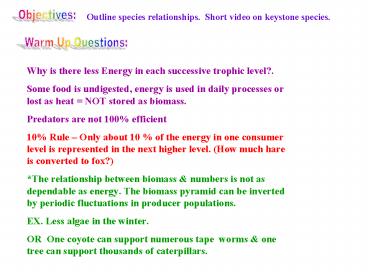Objectives: - PowerPoint PPT Presentation
1 / 14
Title:
Objectives:
Description:
Amount of mass created by producers using the process of ... Grizzly bear & butterfly. Parasitism: One species obtains food at the expense of their host. ... – PowerPoint PPT presentation
Number of Views:42
Avg rating:3.0/5.0
Title: Objectives:
1
Objectives
Outline species relationships. Short video on
keystone species.
Warm Up Questions
2
Objectives
Outline species relationships. Keystone species
video.
Warm Up
Define Net primary production. Amount of mass
created by producers using the process of
photosynthesis. Contrast the pyramid of biomass
with a pyramid of energy. The mass can sometimes
be greater in a marine system at the top whereas
an energy pyramid can never by inverted. Contrast
bottom-up with top-down control. Bottom-up The
producers control the amount of consumers.
Top-down Top consumers control the producers.
3
Chapter 4 Biological Communities Species
Interactions
4
Objective
Outline species interactions. Watch a short video
if time.
Warm Up
Define Complexity The number of species at each
trophic level or the number of trophic levels. A
highly complex community has many trophic levels
with many guilds within each level. A guild
bases an animals niche by how it eats. (Nibblers,
root borers, seed gnawers etc.) The more complex
connected a food web, the better able it is to
withstand disturbance. (Inertia resistance to
perturbations.)
5
Liebigs limit The single factor in shortest
supply relative to demand is the critical
determinant in the distribution.
Victor Shelford Each environmental factor has
both minimum maximum limits beyond which the
species cant survive. The single factor closes
to these survival limits is the critical limiting
factor.
6
The Law of competitive exclusion No two species
will occupy the same niche (The role played by
the species- how it obtains food, relationships
with other species, services it provides the
community.) compete for exactly the same
resources in the same habitat for very long.
Resource partitioning- One will migrate, become
extinct or change its behavior or physiology to
minimize competition.
7
Competition
Intraspecific competition Between members of the
same species, over mates, resources or habitat.
EX Territoriality
Interspecific competition Between members of
different species.
Exploitation Indirect effects reduce resources.
(One eats more no aggression is involved.)
Interference One organism prevents physical
establishment of another by poisoning or other
exclusionary techniques.(aggression)
8
BIOTIC RELATIONSHIPS
Ammensalism One species suffers the other is
not affected. EX. Alleopathy one species
releases a chemical substance to inhibit the
growth of another.
Commensalism One species benefits from the
relationship but the other is neither harmed nor
benefited.
- Mutualism Both benefit
- Symbiotic physical interaction but either
species cannot live without the other. (Lichens) - Nonsymbiotic no physical interactions but
either species cannot live without the other.
(Insect pollinators flowers)
9
Neutralism An interspecific interaction whereby
neither population really affects the other.
Grizzly bear butterfly.
Parasitism One species obtains food at the
expense of their host.
Predation Species obtain food at the expense of
their prey.
Saprophytism one species, especially fungi or
bacteria grow on derive their nutrients from
dead or decaying organic matter.
Video time.
10
COMMUNITY PROPERTIES
Primary productivity rate of biomass production
which indicates the rate of solar energy
conversion to chemical energy. Regulated by
light levels, temp., moisture nutrient level.
Only 0.1 to 0.2 of the light absorbed by leaves
is converted to carbohydrates.
11
Defensive mechanisms Toxic chemicals, body
armor, thorns or spines, noxious odors, poisonous
secretions.
Batesian mimicry- a harmless species that looks
like one that is harmful. (Good for the
prey!) Bats are harmless but people Think they
are scary.
Mullerian mimicry Two species that look similar
both are harmful. (Good for the predator!)
12
COMMUNITY STRUCTURE Relative frequency indicates
the species distribution in the community 0 30
clumps 31 80 randomly distributed 81 100
uniform distribution
Random Due to where resources are
located. Ordered Usually due to biological
competition. Clustered For protection or access
to a resource.
13
Ectones boundaries between adjacent
communities. abundance total of
organisms diversity - of different
species primary productivity rate of biomass
produced (light, temp, moisture, nutrients)
14
50/500 rule 50 minimum population for short
term survival 500 minimum of long term
survival.
Ne 4 Nm x Nf Nm Nf
H loss 1 2 Ne































